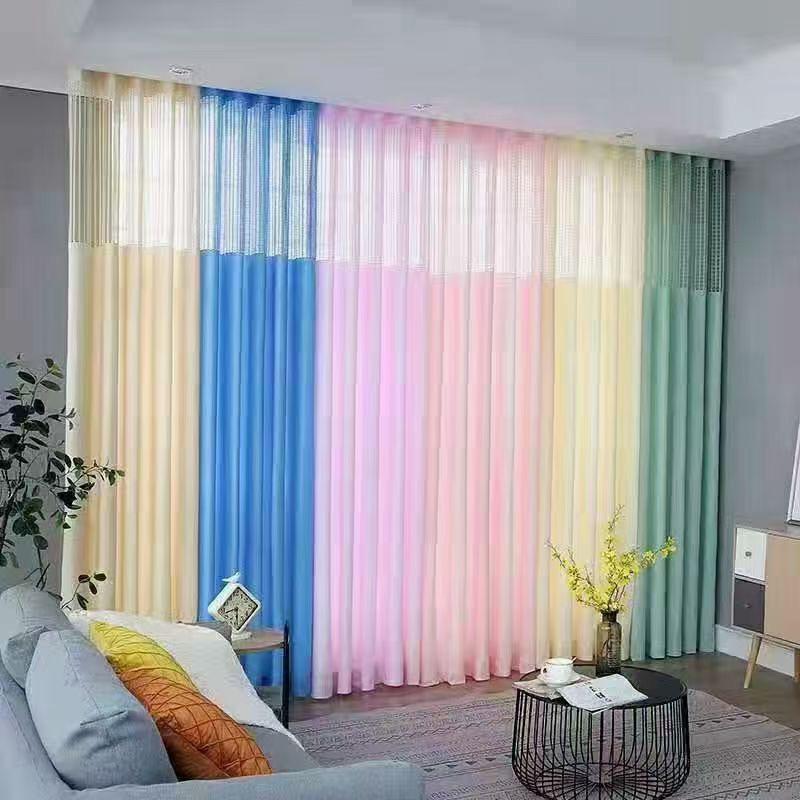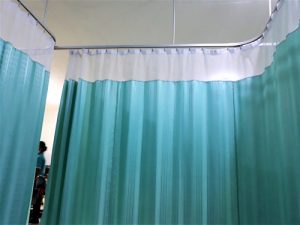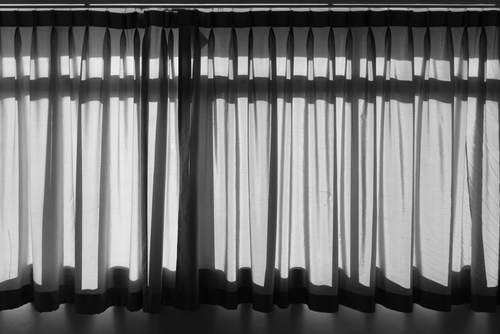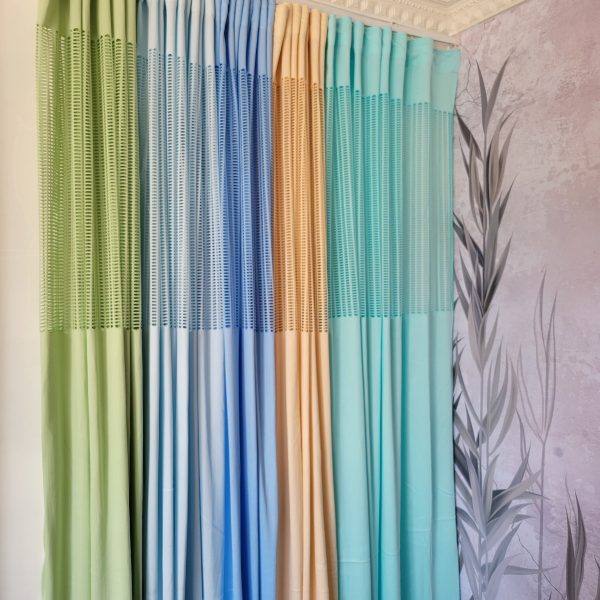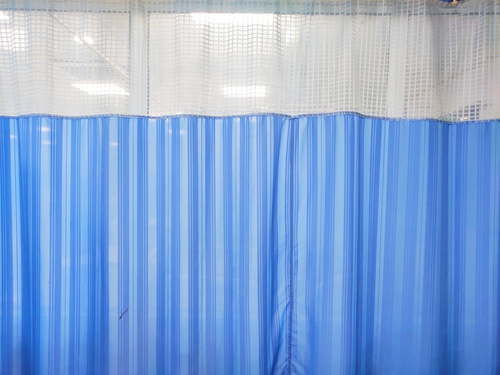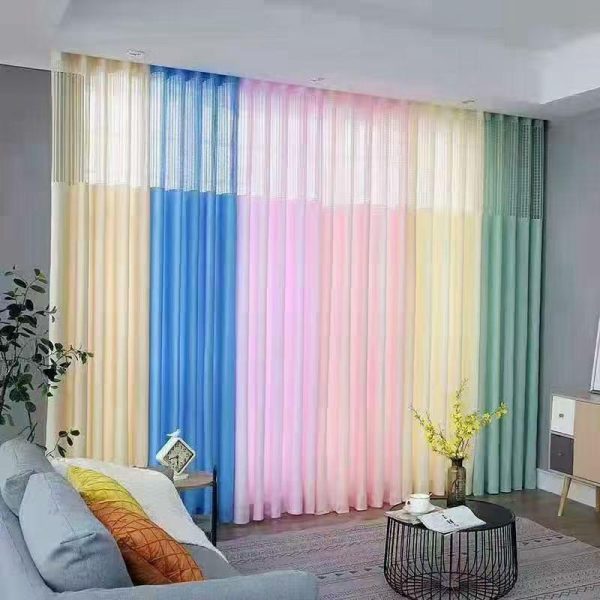Description
Common features of all hospital curtains
The most fundamental purpose of hospital curtains is to provide privacy for patients during examinations, treatments, and recovery.
The curtain fabric creates a physical barrier and helps maintain patient dignity.
Flame retardancy
Hospital curtains are made of flame-retardant materials to comply with safety regulations and minimize the risk of fire spreading.
This is crucial in a healthcare setting where oxygen tanks and other equipment are present.
The vital curtain fabric characteristic helps prevent the spread of fire and protects patients, staff, and the entire facility in case of an emergency.
Why are flame-retardant curtains important in hospitals?
Hospitals are high-risk environments. Open flames, electrical equipment, and the use of oxygen can all pose fire hazards. Flame-retardant curtains can help slow the spread of fire, giving precious time for evacuation and fire suppression.
It also protects vulnerable patients. Because many patients in hospitals are immobile or require additional assistance. Therefore flame-retardant curtains can provide an extra layer of protection in case of a fire, potentially saving lives.
Most countries have strict fire safety regulations for healthcare facilities, which often mandate the use of flame-retardant materials in curtains and other furnishings.
Hospital curtains often have a mesh at the top
Light and Ventilation
The curtain mesh allows natural light to filter through, brightening the patient’s room and reducing the need for artificial lighting. Additionally, it improves air circulation, preventing the room from becoming stuffy and uncomfortable.

Fire Sprinkler Access
In some cases, the curtain mesh is designed to allow access to ceiling-mounted fire sprinklers.
This ensures that the sprinklers can function properly in case of a fire, even if the curtain is drawn.
Reduced Fabric Costs
Using mesh for the top portion of the curtain can save on fabric costs, as it requires less material than a solid fabric panel.

This can be especially beneficial for hospitals with a large number of curtains to maintain.
Sound Dampening
The mesh can also help to dampen noise, creating a more peaceful environment for patients.
Visibility for Staff
With the mesh at the top, staff can easily see if a patient needs assistance without having to open the curtain fully.
While the mesh provides several benefits, it’s important to note that it may not offer the same level of privacy as a solid fabric curtain.
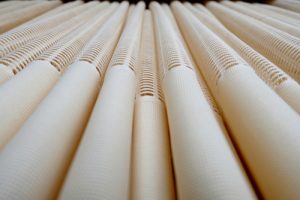
You may choose to use a combination of mesh and solid fabric panels to address both the need for light and ventilation and the need for patient privacy.
Antimicrobial hospital curtains: A shield against germs
Hospital curtains are treated with antimicrobial agents to prevent the growth of bacteria and other pathogens. This helps reduce the risk of infections spreading among patients and staff.
In the battle against healthcare-associated infections (HAIs), hospital curtains often go overlooked. However, these seemingly simple fabrics can play a crucial role in preventing the spread of harmful bacteria and viruses. This is where antimicrobial properties come into play.
What are antimicrobial properties?
Antimicrobial properties in hospital curtains refer to their ability to inhibit the growth and spread of microorganisms like bacteria, fungi, and viruses. This can be achieved in several ways.
- Built-in antimicrobial agents: These are woven into the fabric itself or applied as a topical treatment. They can work by disrupting the cell walls of microorganisms, preventing them from multiplying.
- Self-cleaning surfaces: Some fabrics have inherent antimicrobial properties due to their surface texture or chemical composition. These surfaces make it difficult for microbes to adhere and proliferate.
Why are antimicrobial curtains important?
Hospital curtains are frequently touched by patients, staff, and visitors, making them breeding grounds for pathogens. Antimicrobial curtains can help reduce the risk of HAIs in several ways:
- They prevent bacteria and viruses from colonizing the curtain surface, thereby lowering the overall microbial load in the environment.
- Antimicrobial curtains can contribute to a cleaner and more hygienic hospital environment, reducing the risk of cross-contamination between patients.
- By minimizing the presence of harmful microbes, antimicrobial curtains can help protect vulnerable patients, especially those with weakened immune systems.
Easy to clean and disinfect hospital curtains
Hospital curtains are made of materials that can be easily cleaned and disinfected to maintain a hygienic environment. They are often stain-resistant and can withstand frequent washing and wiping.
Maintaining hygiene in hospitals is paramount, and that includes keeping the curtains clean and disinfected. Here are some options for easy-to-clean and disinfect hospital curtains.
Material matters
- Polyvinyl chloride (PVC) is a waterproof and tear-resistant material wipeable with disinfectant solutions and can be easily spot-cleaned.
- Many polyester blends offer flame retardancy, stain resistance, and easy cleaning with soap and water or disinfectant wipes.
- Microfiber fabric traps dirt and bacteria well and can be machine-washed at high temperatures for thorough disinfection.
- Antimicrobial fabrics infused with copper, silver, or other antimicrobial agents actively inhibit the growth of bacteria and viruses, reducing the need for frequent cleaning.
Cleaning and disinfection methods
- Many hospital curtains can be machine-washed on hot cycles with bleach or a hospital-grade disinfectant detergent. Check the manufacturer’s care instructions for specific guidelines.
- For routine cleaning, use disinfectant wipes or a spray solution followed by wiping with a clean cloth. Always follow the manufacturer’s instructions for the disinfectant solution and ensure it’s compatible with the curtain material.
- Dry steam vapor is an effective and gentle way to disinfect curtains without using harsh chemicals. This method is particularly suitable for curtains that cannot be machine-washed.
Durability
Hospital curtains are subjected to frequent use and wear and tear. They are made of durable materials that can withstand daily pulls, snags, and cleaning without tearing or fading.
Desirable features of hospital curtains
Sound absorption
Hospital curtains can help dampen noise levels in busy hallways and patient rooms, creating a more peaceful and restful environment for patients.
Light control
Certain hospital curtains may be blackout or light-filtering to provide patients with better control over their sleep environment and reduce glare from medical equipment.
Aesthetics
While functionality is paramount, hospital curtains can also be designed with pleasing colors and patterns to create a more calming and welcoming atmosphere for patients.
Aesthetics of Hospital Curtains: Balancing Function and Feelings
The sterile white walls and harsh lighting of traditional hospitals can be intimidating and anxiety-inducing for patients.
While functionality remains paramount, incorporating thoughtful aesthetics into hospital curtains can play a significant role in improving patient experience and overall well-being. Here’s how:
Color and Pattern
Move away from the sterile white hospital curtains and embrace soft hues like blues, greens, and lavenders, which have been shown to promote feelings of peace and relaxation.
Nature-inspired patterns
Bring the outdoors in with subtle leaf or floral patterns to evoke a sense of connection with nature and tranquility.
Playful prints for pediatrics
For children’s wards, incorporate whimsical animal prints or playful geometric patterns to create a more inviting and less clinical atmosphere.
Light and Transparency
Sheer panels
Layer sheer panels over solid curtains to allow natural light to filter through, creating a brighter and more spacious feel.
Light-diffusing fabrics
Opt for fabrics that diffuse light instead of blocking it entirely, reducing glare and creating a softer ambiance.
Blackout options
Provide patients with blackout curtains for better sleep control and privacy, especially in shared rooms.
Material and Texture
- Introduce natural materials like linen or cotton to add a touch of warmth and comfort to the sterile environment.
- Opt for fabrics with subtle raised patterns or woven textures to add visual interest without being overwhelming.
Beyond the Fabric
- Inpatient hallways or waiting areas can benefit from curated artwork displayed alongside curtains, fostering a sense of calm and cultural connection.
- Consider incorporating blinds or shades alongside curtains to offer patients greater control over light and privacy.
Remember, the key is to strike a balance between functionality and aesthetics. Ensure the fabrics you choose comply with hospital safety regulations regarding flame retardancy and hygiene while creating a soothing and welcoming environment for patients.
By implementing these aesthetic considerations, you can transform hospital curtains from purely functional barriers into elements that contribute to a more positive and healing experience for everyone involved.
Ease of use
Hospital curtains should be easy to open and close for both patients and staff. Tracks and hanging systems should be smooth and user-friendly.
Sustainability
You can opt for eco-friendly hospital curtains made from recycled materials or with sustainable manufacturing practices.
I hope this information is helpful! Let me know if you have any other questions.
Disposable hospital curtains
Disposable hospital curtains are used in a variety of healthcare settings to provide privacy and separation for patients.
Here are some common situations where they might be needed:
Inpatient care
- You can use curtains to partition off sections of a shared patient room to give patients more privacy.
- They can also be used to separate the examination area from the rest of the room for patient privacy during procedures.
- And also use curtains to provide privacy for patients using hospital bathrooms and changing areas.
Outpatient care
- You can use curtains to create temporary partitions in waiting rooms to give patients more privacy, especially when they are discussing sensitive medical information.
- Procedure rooms: Curtains can be used to separate different treatment areas within a single room for patient privacy and to prevent the spread of germs.
- Ambulatory surgery centers: Curtains can be used to separate patients in recovery areas and to create temporary privacy dividers in hallways.
Other healthcare settings
- Disposable curtains are often used in mobile medical units to create temporary examination and treatment areas.
- Disposable curtains can be used to create temporary medical facilities in disaster zones.
Your specific need for disposable curtains will vary depending on your healthcare setting and the specific procedures you perform. However, they are versatile tools that can help ensure your patients’ privacy and comfort in a variety of situations.
Both disposable and reusable hospital curtains have their pros and cons. And choosing between them depends on your specific needs and priorities.
Here’s a breakdown of the advantages and disadvantages.
Disposable Hospital Curtains
Advantages
- Disposable curtains eliminate the risk of cross-contamination from repeated washing, particularly valuable in isolation rooms or during outbreaks.
- They are convenient with no need for laundry facilities or labor, saving time and staff resources.
- Soiled curtains can be discarded immediately, simplifying cleaning procedures.
- Disposable curtains are often perceived as looking newer and cleaner, contributing to aesthetics and a positive patient experience.
Disadvantages
- Disposable curtains can be more expensive in the long run, especially with frequent replacements.
- They generate waste and contribute to landfills unless specifically made from recyclable materials.
- And are generally less durable than reusables, prone to tears, and require more frequent replacements.
- Some disposable curtains may not meet the same fire safety standards as reusables, posing a potential risk.
Reusable Hospital Curtains
Advantages
There are several heavy advantages of reusable curtains over disposable curtains:
- Lower overall cost in the long run, especially with proper maintenance.
- Reduces waste and promotes sustainability.
- Made from sturdier materials, lasting longer and requiring fewer replacements.
- Typically meets stringent fire safety standards.
Disadvantages
- Requires thorough cleaning and regular sanitization to prevent cross-contamination.
- Cleaning and maintenance take time and staff resources.
- Risk of bacteria build-up if not cleaned properly.
- May appear worn over time, potentially impacting patient perception.
Ultimately, the best choice depends on your priorities. If infection control and convenience are primary concerns, disposable curtains might be preferable, especially in high-risk areas. However, if cost-effectiveness and sustainability are crucial, reusable curtains might be a better long-term solution. Consider factors like frequency of use, cleaning resources, and environmental impact to make an informed decision.
Hospital cubicle curtains’ hardware
The humble hospital cubicle curtain might seem like a simple piece of equipment.
However, the hardware that keeps it hanging smoothly and functioning effectively plays a crucial role in maintaining patient privacy, ensuring infection control, and even contributing to the overall hospital ambiance.
Let’s dive into the fascinating world of hospital cubicle curtain hardware.
Track Systems
Ceiling Tracks
These are the most common type of hospital curtain track systems, suspended from the ceiling and allowing curtains to glide effortlessly across the entire cubicle length.
They come in various materials like aluminum, PVC, and stainless steel, with options for single or double tracks to accommodate multiple curtains.
Wall Tracks
Wall-mounted tracks offer you a space-saving alternative, particularly in rooms with low ceilings. They can be straight or curved, depending on the layout of your cubicle.
Flexible Tracks
These flexible innovative tracks bend around corners and columns, providing you flexibility for irregularly shaped spaces. They’re often made from lightweight materials like nylon or PVC.
Carriers and Gliders
Carriers
These are the small hooks or clips that attach the curtain to the track. They come in various styles, like rollers, gliders, or snap-lock mechanisms, ensuring smooth movement and secure attachment.
Gliders
Some tracks use gliders instead of carriers, which are small plastic or metal fittings sewn directly onto the curtain header. They slide silently along the track, offering you a quieter and streamlined solution.
Additional Hardware
End Stops
These prevent the curtain from sliding off the end of the track. They can be simple stoppers or incorporate features like magnets or locks for added security.
Connectors
For longer cubicle tracks, connectors enable seamless joining of multiple sections, ensuring smooth curtain movement across the entire span.
Privacy Curtain fabrics
While not technically hardware, privacy curtain fabrics are an essential part of the system. They’re typically made from flame-retardant, anti-microbial, and easy-to-clean fabrics, often coming in various colors and patterns to create a more pleasant environment.
Choosing the Right Hospital Cubicle Curtains’ Hardware
Selecting the right hardware depends on several factors, including:
- Cubicle layout and size
- Desired level of privacy and security
- Budget and aesthetic considerations
- Infection control protocols
By considering these factors and choosing the appropriate hardware, you can ensure your hospital cubicle curtains provide optimal functionality, contribute to a safe and hygienic environment, and even enhance the overall patient experience.
Beyond the practicalities, hospital cubicle curtain hardware also offers a glimpse into the dedication and innovation behind creating a secure and comfortable space for patients. From cleverly designed tracks to discreet privacy locks, each component plays a role in safeguarding patient well-being and contributing to the smooth operation of healthcare facilities.
So, the next time you glance at a hospital cubicle curtain, remember: it’s not just hanging there. It’s held up by a hidden world of hardware, working tirelessly to ensure privacy, hygiene, and comfort for those seeking medical care.


